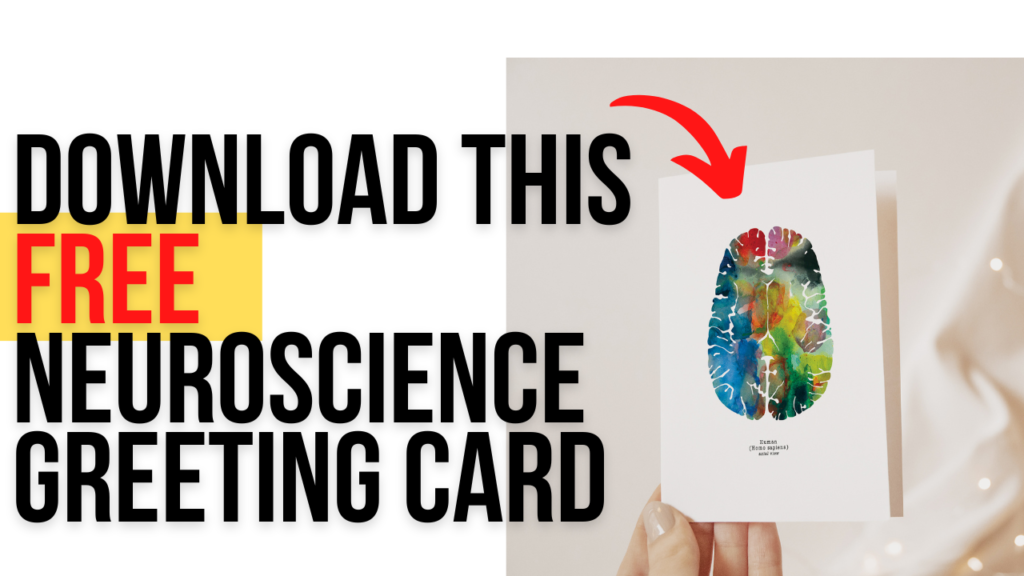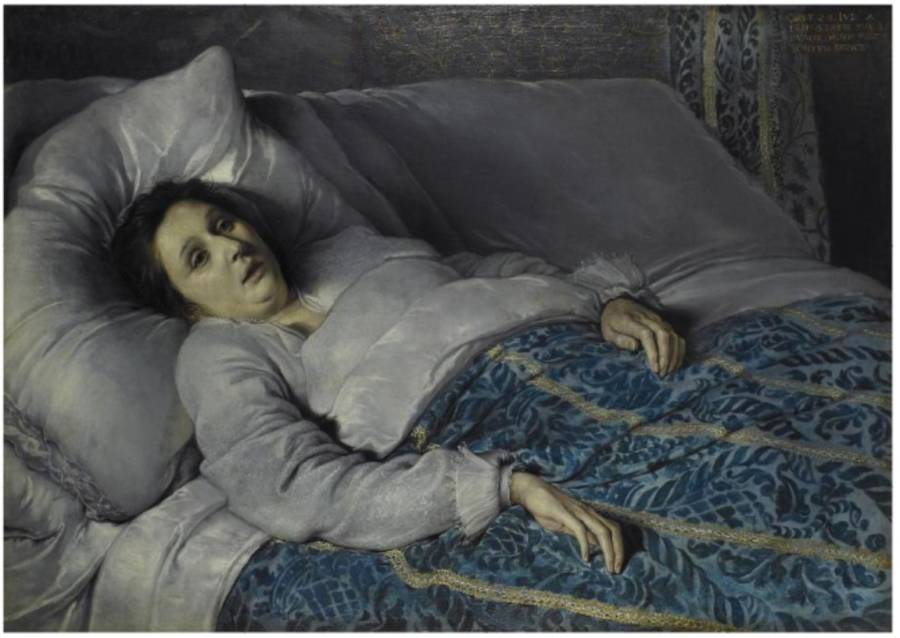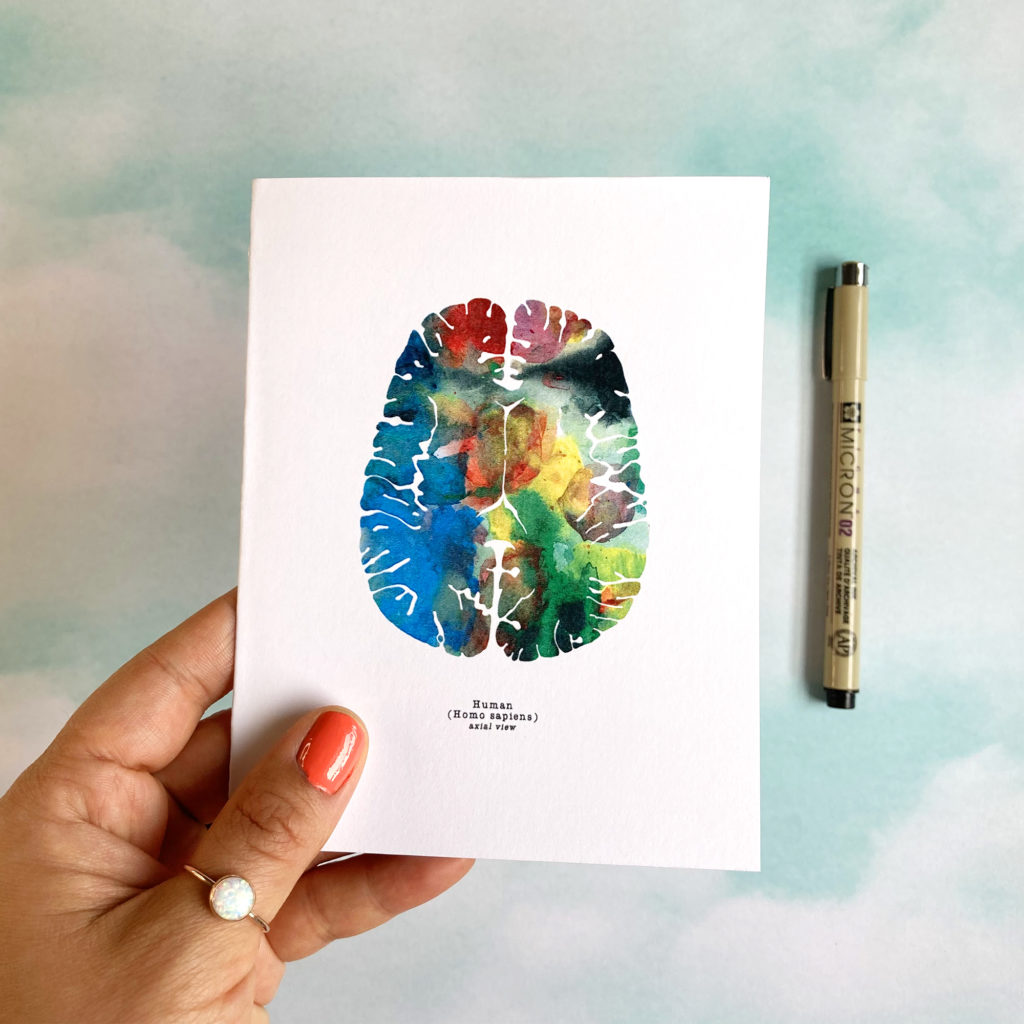This history of neuroscience uncovers the 5 strangest brain oddities that have left scientists, scholars, and curious minds alike in awe. From the mind-bending case of Phineas Gage to the surreal journey of Einstein’s brain, these anomalies challenge our understanding of the intricate organ that governs our thoughts, emotions, and perceptions.
Free Psychology Greeting Card
Before we unravel these peculiar tales, bring the human brain’s mystique into your world with our free psychology greeting card! This artwork features the brain art of artist, J. Sayuri. Crafted with creativity and care, these cards blend science and art, offering a unique way to connect with loved ones.

Crafted with care and designed for psychology enthusiasts, our downloadable card is a unique expression of appreciation for the intricacies of the human psyche. Whether you’re a psychology student, professional, or someone who simply cherishes the beauty of the brain, this card is a delightful way to convey your sentiments. Head over to [blog post link] to access the free printable, and join us in spreading thoughtful and artistic joy with our exclusive brain art greeting card. Let your heartfelt messages shine with a touch of cerebral elegance!
If you are downloading this printable greeting card to write a thank you letter for your therapist, please see our blog post about that.
Free Printable Greeting Card
Simply let us know where to send your brain art greeting card and we will send to you right away. Feel free to print this neuroscience greeting card as many times as you’d like.

Now, let’s get into the 5 strangest brain anomalies in human history, starting with Phineas Gage.
1. Phineas Gage
A man named Phineas Gage became an unexpected and fascinating figure in neuroscience. Born in 1823 in New Hampshire, Gage worked as a foreman on the Rutland & Burlington Railroad in Vermont.

On September 13, 1848, during a routine day on the job, an accidental explosion propelled a 3.5-foot-long, 1.25-inch-diameter iron rod through Gage’s skull. The rod entered below his left cheekbone and exited through the top of his head, landing several feet away. Astonishingly, Gage remained conscious throughout the ordeal.
Phineas Gage survived, but the incident left an indelible mark on his life. The rod had pierced through his frontal lobe, a region of the brain associated with personality and impulse control. Previously described as a responsible, diligent, and reserved individual, Gage underwent a profound and immediate transformation.

Dr. John Martyn Harlow, the physician who attended to Gage, noted: “The equilibrium or balance, so to speak, between his intellectual faculties and animal propensities, seems to have been destroyed. He is fitful, irreverent, indulging at times in the grossest profanity (which was not previously his custom)…”
Gage’s friends and family also struggled to reconcile the post-accident personality with the man they knew. One of his acquaintances remarked, “Gage was no longer Gage.” Another noted the drastic shift in his character, describing him as “no longer himself.” These firsthand accounts underscored the dramatic alterations in Gage’s behavior and demeanor.
The significance of Phineas Gage’s case became a crucial milestone in understanding the link between specific brain regions and behavioral traits. Dr. Harlow’s observations provided early evidence that damage to the frontal lobe could result in marked changes in personality and social behavior.
2. Albert Einstein’s Brain:

As the 20th century dawned, the scientific community found itself entwined in a surreal tale that involved none other than the iconic Albert Einstein. Following his demise on April 18, 1955, Einstein’s brain would raise profound questions about ethics and science.
In the wake of Einstein’s death, pathologist Thomas Stoltz Harvey performed the autopsy at Princeton Hospital in New Jersey. During this post-mortem examination Harvey set in motion a bizarre journey for Einstein’s brain.
Harvey surreptitiously removed Einstein’s brain for further study, claiming that he sought to unravel the mysteries behind Einstein’s extraordinary intellect. However, the decision was made without the permission of Einstein’s family, sparking immediate controversy and ethical concerns. Harvey, acting with a sense of scientific duty, preserved the brain in formaldehyde and divided it into numerous sections for analysis.

However, he soon found himself dismissed from his position at Princeton Hospital, taking Einstein’s brain with him.
Over the next decades, Einstein’s brain changed hands multiple times – becoming a relic sought after by scientists eager to unlock the secrets of genius. It passed through the possession of researchers, institutions, and even journalists. The brain’s peregrinations fueled debates over the ethics of post-mortem studies, informed consent, and the boundaries of scientific inquiry.
3. Chang and Ed Bunker
Chang and Eng Bunker were a pair of conjoined twins who challenged societal norms and scientific understanding. Born in 1811 in Siam (present-day Thailand), Chang and Eng Bunker were conjoined twins connected by a small band of flesh at the chest.

Chang and Eng Bunker’s physical connection was a result of a biological anomaly. Yet, despite this shared anatomy, the twins led incredibly independent and extraordinary lives. They embarked on a global tour which captivated audiences. Along the way, they married two sisters, Adelaide and Sarah Ann Yates, and collectively fathered an astounding total of 21 children. The sheer complexity of their lives challenged societal perceptions of identity, love, and family.
The neuroscientific exploration of Chang and Eng Bunker’s case delves into the profound questions surrounding the role of the brain in shaping individuality and consciousness.

Researchers and scientists pondered the following neurological questions:
- Shared Sensation and Perception: With their physical connection, did Chang and Eng share sensations and perceptions? How did their brains process sensory information?
- Motor Control and Coordination: Given the physical proximity of their bodies, how did the twins coordinate their movements? How did their brains control shared limbs while maintaining independence?
- Cognitive Processes and Decision-Making: What cognitive processes were shared between the twins, and to what extent did their decision-making reflect the interplay of two distinct consciousnesses?
- Identity and Self-Perception: How did the twins perceive their own identities? Did they develop a shared sense of self, or did each twin maintain a distinct sense of individuality despite their physical connection?
4. Splitting Brains
In the mid-20th century, neuroscientists Roger Sperry and Michael Gazzaniga studied split-brain patients. These are people who had undergone a surgical procedure to sever the corpus callosum and unearthed profound insights into the specialization of each hemisphere and revolutionized our understanding of brain lateralization.

The corpus callosum, a bundle of nerves connecting the brain’s hemispheres, facilitates communication between the left and right hemispheres. In cases of severe epilepsy where traditional treatments failed, surgeons, including Sperry and Gazzaniga, resorted to a procedure known as callosotomy, effectively severing the corpus callosum. This drastic intervention aimed to prevent the spread of epileptic seizures from one hemisphere to the other.
Sperry and Gazzaniga’s experiments involved studying the cognitive and perceptual effects of this surgical intervention. By presenting stimuli to one visual field at a time and analyzing the responses, the researchers uncovered a wealth of information about the distinct functions of the left and right hemispheres.

Insights into the Left Brain:
- Language Processing: The left hemisphere, particularly in right-handed individuals, was found to be predominantly responsible for language processing. When visual information was presented to the right visual field (projecting to the left hemisphere), split-brain patients could accurately describe or name objects. This highlighted the left hemisphere’s specialization in linguistic abilities.
- Logical Reasoning: Logical reasoning and analytical thinking were also associated with the left hemisphere. When asked to solve problems or perform tasks requiring sequential reasoning, split-brain patients demonstrated enhanced abilities when information was presented to the right hemisphere.
- Fine Motor Skills: Fine motor skills, especially those involving the right hand, were more effectively controlled by the left hemisphere. This connection explained the observed dexterity and precision in tasks requiring coordinated hand movements in split-brain patients.
Insights into the Right Brain:
- Spatial Abilities: The right hemisphere emerged as the powerhouse for spatial abilities. When visual information was presented to the left visual field (projecting to the right hemisphere), split-brain patients excelled in tasks involving spatial perception, such as identifying objects’ positions in space.
- Visual Recognition: The right hemisphere demonstrated a crucial role in visual recognition. When patients were shown images in the left visual field, they could identify non-verbal stimuli and patterns, showcasing the right hemisphere’s specialization in holistic visual processing.
- Emotional Processing: Emotional processing was found to be lateralized to the right hemisphere. Split-brain patients showed enhanced emotional responses when emotional stimuli were presented to the left visual field, indicating the right hemisphere’s involvement in emotional expression and interpretation.
5. The Cotard Delusion
The Cotard Delusion is a rare psychiatric disorder shows the intricate interplay between brain function and psychological well-being. In this peculiar phenomenon individuals grapple with the profound conviction that they are dead, non-existent, or have lost vital organs.

Historical accounts of Cotard Delusion date back to the late 19th century, with Jules Cotard, a French neurologist, describing the condition as “negation delirium.” Notable cases include individuals expressing the belief that they had lost their internal organs or were existing in a state of damnation.
Neuroscientific investigations into Cotard Delusion have revealed intriguing insights. Functional imaging studies suggest abnormal activity in specific brain regions, including the parietal cortex, associated with self-awareness. The disconnect between cognitive processes and self-perception plays a crucial role in the development of this delusion.

Exploring the depths of Cotard Delusion unveils the fragility and complexity of the human mind. It also underscores the crucial need to understand both neurological and psychological aspects of mental health.
Conclusion
In conclusion, the human brain captivates us with its intricate workings. In neuroscience, our understanding of this complex organ has expanded exponentially over the years, unraveling secrets once shrouded in mystery. Yet, the more we learn, the more we realize how much remains undiscovered. The journey of unraveling its mysteries is an ongoing exploration, with each revelation opening new avenues of inquiry. As technology advances and research evolves, the future promises even more profound insights into the workings of our cognitive powerhouse. The voyage into neuroscience continues, reminding us that the brain’s wonders is yet to be fully unveiled.
Free Greeting Card Download
And if you or anyone you know would like to receive a free printable neuroscience greeting card, please consider downloading ours! As always, you can see more neuroscience brain art by artist, J. Sayuri on her Etsy store

